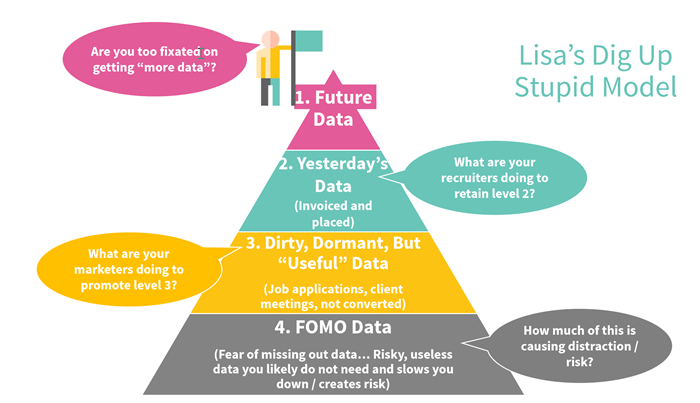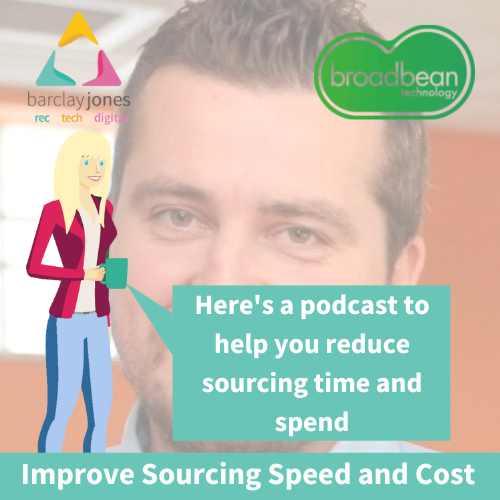This is a valuable read for recruitment leaders and recruitment marketers, who want to grow their business through systems and data, as well as people. (And want to stop saying "Doh!")
Recruitment leaders investing in new technology for their businesses aren’t simply buying a handy tool, they’re investing in the future of their growing staffing companies too! But how can we ensure that the purchase delivers and doesn’t just become a data-comfort-blanket supported by expensive third-party systems? Andy Ingham of Bullhorn and I recently explored this during a live recruitment "5 Techy tips to increase clients, candidates, and profit" webinar, and have some key takeaways for recruitment CRM ROI. Plus some ideas for GDPR safety. We tackled five areas – the first is below, and I’ll be writing about the other four in future posts.
Recruitment CRM is Never Just About the Purchase
As a recruitment leader buying recruiting software, you’re also investing in the improved cost of hire and cash flow, the speed of delivery, happy and retained staff, loyal clients, and relevant, placeable candidates.
But, with all of the “kit” available today how can you ensure that your recruitment CRM is “first to use” to help your teams with their 3Cs – candidates, client, consultants? And how can you ensure that you only buy the extra third-party apps, licences and systems that you genuinely need?
Too Much Data, Not Enough Information? Doh!
With the advent of what I call the "too much data, not enough information" model which recruiters have to wade through every day, your CRM has never been more critical and the data in it has never been more precious, but it is worth considering whether there is a disconnect between your data and your processes.
76% of the marketers we polled last year admitted to not having viable access to their CRM, and recruiters we spoke to revealed that 80% of the placements they made in 2017 were on their system all along (but sourced for the placed vacancy from a third party system). This is definitely not the CRMFirst approach required to make the most of the 3Cs – unsurprising given that GDPR created panic, and data became a curse.
Yet, there is a lot of talk online that suggests data is, in fact, the opposite of a curse. That great data should enable recruiters to source and sell, managers to manage, directors or owners to drive and direct, and businesses to grow. And best of all? That data could already be in your CRM. But is the average recruitment business using their data to make data-driven decisions?
According to a recent Cube19 survey, over 50% of staffing companies were not making decisions based on data. There is a perception that there are talent shortages, and this – coupled with too many systems and not enough processes – causes stress. This suggests tells me that either the data on your recruitment CRM is not fit for purpose, or perhaps the process and the perception of your technology is the issue. So we must wonder if this is the case, what they are basing their decisions on?
A Simple Formula for Recruiters Who Need Data
If you want to know how much data you need to fuel your recruitment engine, ask yourself some simple questions:
How many candidates does the average recruiter need?
How many contacts does your average recruiter need?
How much data does your marketing function need to nurture so your recruiters can focus on converting real candidates and clients?
What systems and processes does your marketer have for nurturing and spotting talent or leads? Their job is to generate MQLs (marketing qualified leads) and relevant talent for jobs.
Too Much Data, Not Enough Candidates? Doh!
Many recruitment businesses suffer from too much data, not enough candidates (or clients). So, try this simple data segmentation trick, or data layers “hack” (I call it my "dig up stupid" model (Thanks Homer Simpson.)
Future Data: What data do you want in the future? Decide and communicate this to your recruiters and marketers, and build processes to ensure that you not only attract this data but that you convert it and get it bought into you! Ideally get it to “subscribe” to you.
Yesterday's Data: What data have you “billed and placed” Who have you placed? Who have you invoiced? Perhaps in the last 3 years? Hopefully, these people are happy to hear from you and be retained by you. Again, communicate this to your business and build processes to nurture and retain.
Dirty "Useful" Data: What data have you not quite converted but wish you had? Is it yesterday’s dormant data? If you didn’t place or invoice it, look for it and get your marketers on the case to help you convert up a layer!
Risky "Useless" Data: Your FOMO (fear of missing out) data? This is likely to be your biggest layer. This is a tricky, sticky, down at the earth’s core layer. It should be way down your list of data to source from. It’s data you have been collecting for years, but that you have not really used. It’s likely to be massively disruptive if you get your recruiters accessing it and likely to set off GDPR alarms. I’d suggest you leave it well alone, and / or get your marketers to gently “poke” it to see if it could be promoted up a layer and so on.

3 Takeaways for Leaders Who Want to Fuel Their Recruitment Businesses
Your CRM will only work if you have data to fuel it.
Your data is only worth something if you have segmented it and have processes to mine it, refine it, and place / invoice it.
Segment your data and have a workflow which includes sales and marketing to nurture, convert and retain.
These takeaways will drive your 4Cs (candidates, clients, colleagues, and cash) strategy.
Watch our Bullhorn Webinar Here
We work with Recruitment and IT leaders to deliver an ROI and sales-led recruitment technology strategy. Our mantra is “CRMFirst”!
HIIT Us, Recruiters!
Our high intensity interval training - Recruitment HIIT - helps recruiters source, convert quicker, and develop healthy pipelines, and recruitment marketers attract, engage, and retain candidates, generate leads, and colleagues (3Cs).
TRY RECRUITMENT HIIT FOR FREE
READ ABOUT OUR BULLHORN TRAINING
BOOK A CALL TO DISCUSS BULLHORN TRAINING
media centre
Read more-
Blog
Bullhorn Tip - Source with Notes
I've got a simple Bullhorn1st 1-minute tip to help you source quicker and stay in touch with your candidates and clients. Spending countless hours sourcing, and also sourcing outside of Linkedin, can be a waste of time and money. One of my favourite Bullhorn features is its Advanced Notes search.(If you haven't got this feature ask your Bullhorn admin to add it for you...) It's Time to Use Advanced Notes! I love how it helps me source, but also how it helps me find candidates (and clients) that I have not spoken to in a while and I need to get in touch with (and keep warm!)Simple! Watch my 1-minute Bullhorn tip - then log in to Bullhorn and try it. Who can you find? Who do you need to KIT (keep in touch) with? Watch My Bullhorn Tip on How to Use Advanced Notes to Source and KITNeed more Linkedin / Bullhorn / Automation / Recruitment Tips? Try our 1-minute tips.Be sure to sign up for (or watch the recordings of) our regular free Bullhorn and Automation webinars.CHECK OUT OUR WEBINARSRecruitment TrainingWe deliver the best Recruitment and Bullhorn training through live webinars and our online training platform, Recruitment HIIT.Our recruitment training helps new and experienced recruiters qualify their jobs, speedily source and advertise, and improve their screening. It boosts CV to interview ratios, whilst giving great tips to prevent counter offers, and secure the placement and beyond.Plus, if you have Bullhorn, Analytics, Automation, SourceBreaker, LinkedIn, Calendly, Teams, Daxtra, Broadbean, idibu, Hinterview, Paiger, Adapt, we train on those too!TRY HIIT FREE HERE
-
Blog
LinkedIn Tip - Lead Gen and More Sales in 1 Minute
I've got a cute 1-minute tip to generate leads with LinkedIn.I genuinely think LinkedIn is a big dirty data dump. Many of my clients are wanting to reduce reliance on it, or at least get more value (rather than spend) from it.In my LinkedIn HIIT course I give lots of hacks to help you focus your time and attention on quick wins, so you can get in, get out, and get back to recruitment.One of my favourite tips is using LinkedIn to find easy leads in 1 minute a day. LinkedIn Job Changes Hack!If you've been following my other tips on HIIT, you'll know that spending 1 minute a day connecting with people in your niche is a good habit.So, too, is checking your community and seeing if they are moving about, celebrating promotions, AKA giving you excuses to call them.Make this a 1 minute a day habit too! And whilst you're doing this, look for opportunities to "weed" your community. People who have left it needn't take up valuable space in your network.Win!Weed! Watch my 1-minute LinkedIn tip - then go to Linkedin check your Celebrations page! Any leads there?Watch My LinkedIn Tip to Get Some LeadsNeed more Linkedin / Bullhorn / Automation / Recruitment Tips? Try our 1-minute tips.Be sure to sign up for (or watch the recordings of) our regular free Bullhorn and Automation webinars.CHECK OUT OUR WEBINARSRecruitment TrainingWe deliver the best Recruitment and Bullhorn training through live webinars and our online training platform, Recruitment HIIT.Our recruitment training helps new and experienced recruiters qualify their jobs, speedily source and advertise, and improve their screening. It boosts CV to interview ratios, whilst giving great tips to prevent counter offers, and secure the placement and beyond.Plus, if you have Bullhorn, Analytics, Automation, SourceBreaker, LinkedIn, Calendly, Teams, Daxtra, Broadbean, idibu, Hinterview, Paiger, Adapt, we train on those too!TRY HIIT FREE HERE
-

Downloads
Your Recruitment Training Playbook
.png)
.png)
.png)
.png)

.png)

